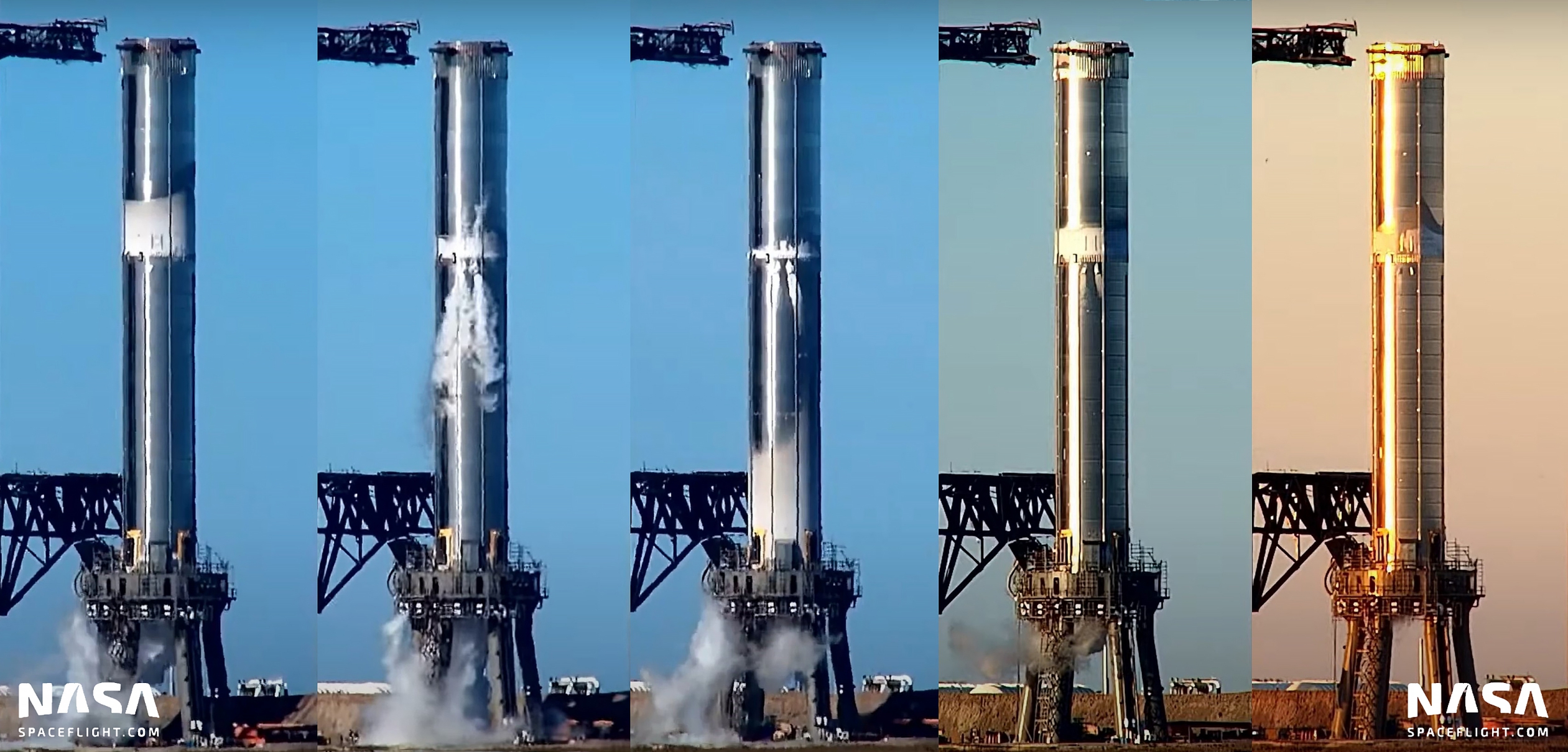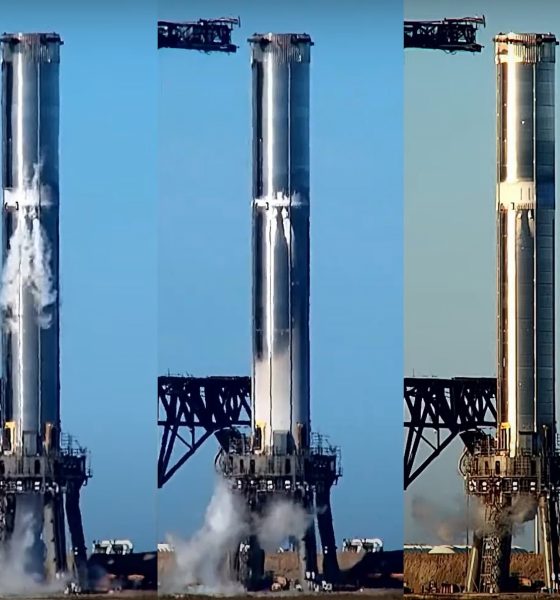

News
SpaceX begins testing first flightworthy Super Heavy booster
More than three months after the building-sized Starship booster’s latest return to Starbase’s orbital launch site, SpaceX has finally begun the process of testing what CEO Elon Musk says is still the first flightworthy Super Heavy.
After completing a number of pad tests in the days prior, SpaceX began filling Super Heavy Booster 4 (B4) with liquid nitrogen – supplied by the first orbital-class Starship launch – for the first time on December 17th. It’s unclear exactly what was done during the test but regardless of what transpired, the test and B4’s survival were a major, long-awaited milestone for both the Starship booster and the orbital launch site (OLS).
At this point in time, the general consensus among close followers of SpaceX’s Starship program is that the unprecedented amount of time it’s taken the company to complete Booster 4’s first test was not because of the rocket itself but rather because the orbital launch site needed to fully test it had yet to be completed. While it was SpaceX’s choice to not perform some kind of initial testing with B4 at one of the site’s two suborbital test and launch mounts, it’s clear that the company ultimately concluded that Super Heavy Booster 3’s successful July 2021 tests – including a cryogenic proof virtually identical to Booster 4’s first test – made such partial testing redundant.
Put a different way, SpaceX must already be confident enough in the quality of the first few Super Heavies rolling out of its Starbase factory to deem it unnecessary to verify the structural integrity of the first truly completed Super Heavy booster before putting the one and only orbital Starship launch site directly in the line of fire. Nonetheless, depending on how far Super Heavy Booster 4’s first cryogenic proof test went, it appears that SpaceX’s presumptions were correct.
On December 17th, SpaceX subjected Super Heavy B4 to a cryogenic proof test about twice as ambitious as B3’s, filling the booster maybe a sixth of the way with a few hundred tons of liquid nitrogen (LN2). What isn’t clear is if that test also raised the booster’s propellant tanks to flight pressures (6-8 bar or 90-115 psi). If Booster 4 did reach those pressures, the test is even more significant – partially proving that the rocket is ready for flight. On December 21st, SpaceX performed a similar series of cryogenic tests, again partially filling Booster 4 with about the same amount of liquid nitrogen but doing so two or three times in a row. Again, the Super Heavy survived the several-hour ordeal without any obvious issues. Still, a number of additional tests – some even more important – are still in front of SpaceX and Super Heavy B4.
The most obvious is simple enough: SpaceX needs to fully fill a Super Heavy booster for the first time. Depending on the storage situation, that process will likely begin by filling Booster 4 with about 2500 tons (5.5M lb) of liquid nitrogen (LN2) – about two-thirds full. If SpaceX also temporarily fills one of the orbital tank farm’s liquid oxygen (LOx) or methane (LCH4) tanks with nitrogen, it could fully load Booster 4 with around 3500 tons (7.7M lb) of nitrogen. At least according to SpaceX’s own website, that’s about the same weight as the propellant (3400t/7.5M lb) Super Heavy is designed to lift off with. If that full cryoproof goes well, SpaceX will then likely perform one or several wet dress rehearsals, ultimately filling Booster 4 with approximately 2900 tons (6.4M lb) of cryogenic oxygen and 500 tons (1.1M lb) of cryogenic methane.
Finally, SpaceX will probably kick off static fire testing, likely beginning by igniting just one or a few of Super Heavy’s many engines. Eventually, that process could culminate in the ignition of all 29 of Booster 4’s Raptors, briefly producing a bit less than 5400 tons (~11.9M lbf) of thrust – 50% more powerful than NASA’s retired Saturn V Moon rocket.
According to Elon Musk, despite a number of recent signs and reports to the contrary, SpaceX still intends to fly Booster 4 and Ship 20 on Starship’s first orbital-velocity launch attempt, so the scope and scale of testing are only likely to grow over the next several weeks.

Elon Musk
Elon Musk’s X will start using a Tesla-like software update strategy
The initiative seems designed to accelerate updates to the social media platform, while maintaining maximum transparency.

Elon Musk’s social media platform X will adopt a Tesla-esque approach to software updates for its algorithm.
The initiative seems designed to accelerate updates to the social media platform, while maintaining maximum transparency.
X’s updates to its updates
As per Musk in a post on X, the social media company will be making a new algorithm to determine what organic and advertising posts are recommended to users. These updates would then be repeated every four weeks.
“We will make the new 𝕏 algorithm, including all code used to determine what organic and advertising posts are recommended to users, open source in 7 days. This will be repeated every 4 weeks, with comprehensive developer notes, to help you understand what changed,” Musk wrote in his post.
The initiative somewhat mirrors Tesla’s over-the-air update model, where vehicle software is regularly refined and pushed to users with detailed release notes. This should allow users to better understand the details of X’s every update and foster a healthy feedback loop for the social media platform.
xAI and X
X, formerly Twitter, has been acquired by Elon Musk’s artificial intelligence startup, xAI last year. Since then, xAI has seen a rapid rise in valuation. Following the company’s the company’s upsized $20 billion Series E funding round, estimates now suggest that xAI is worth tens about $230 to $235 billion. That’s several times larger than Tesla when Elon Musk received his controversial 2018 CEO Performance Award.
As per xAI, the Series E funding round attracted a diverse group of investors, including Valor Equity Partners, Stepstone Group, Fidelity Management & Research Company, Qatar Investment Authority, MGX, and Baron Capital Group, among others. Strategic partners NVIDIA and Cisco Investments also continued support for building the world’s largest GPU clusters.
News
Tesla FSD Supervised wins MotorTrend’s Best Driver Assistance Award
The decision marks a notable reversal for the publication from prior years, with judges citing major real-world improvements that pushed Tesla’s latest FSD software ahead of every competing ADAS system.

Tesla’s Full Self-Driving (Supervised) system has been named the best driver-assistance technology on the market, earning top honors at the 2026 MotorTrend Best Tech Awards.
The decision marks a notable reversal for the publication from prior years, with judges citing major real-world improvements that pushed Tesla’s latest FSD software ahead of every competing ADAS system. And it wasn’t even close.
MotorTrend reverses course
MotorTrend awarded Tesla FSD (Supervised) its 2026 Best Tech Driver Assistance title after extensive testing of the latest v14 software. The publication acknowledged that it had previously criticized earlier versions of FSD for erratic behavior and near-miss incidents, ultimately favoring rivals such as GM’s Super Cruise in earlier evaluations.
According to MotorTrend, the newest iteration of FSD resolved many of those shortcomings. Testers said v14 showed far smoother behavior in complex urban scenarios, including unprotected left turns, traffic circles, emergency vehicles, and dense city streets. While the system still requires constant driver supervision, judges concluded that no other advanced driver-assistance system currently matches its breadth of capability.
Unlike rival systems that rely on combinations of cameras, radar, lidar, and mapped highways, Tesla’s FSD operates using a camera-only approach and is capable of driving on city streets, rural roads, and freeways. MotorTrend stated that pure utility, the ability to handle nearly all road types, ultimately separated FSD from competitors like Ford BlueCruise, GM Super Cruise, and BMW’s Highway Assistant.
High cost and high capability
MotorTrend also addressed FSD’s pricing, which remains significantly higher than rival systems. Tesla currently charges $8,000 for a one-time purchase or $99 per month for a subscription, compared with far lower upfront and subscription costs from other automakers. The publication noted that the premium is justified given FSD’s unmatched scope and continuous software evolution.
Safety remained a central focus of the evaluation. While testers reported collision-free operation over thousands of miles, they noted ongoing concerns around FSD’s configurable driving modes, including options that allow aggressive driving and speeds beyond posted limits. MotorTrend emphasized that, like all Level 2 systems, FSD still depends on a fully attentive human driver at all times.
Despite those caveats, the publication concluded that Tesla’s rapid software progress fundamentally reshaped the competitive landscape. For drivers seeking the most capable hands-on driver-assistance system available today, MotorTrend concluded Tesla FSD (Supervised) now stands alone at the top.
News
Elon Musk’s Grokipedia surges to 5.6M articles, almost 79% of English Wikipedia
The explosive growth marks a major milestone for the AI-powered online encyclopedia, which was launched by Elon Musk’s xAI just months ago.

Elon Musk’s Grokipedia has grown to an impressive 5,615,201 articles as of today, closing in on 79% of the English Wikipedia’s current total of 7,119,376 articles.
The explosive growth marks a major milestone for the AI-powered online encyclopedia, which was launched by Elon Musk’s xAI just months ago. Needless to say, it would only be a matter of time before Grokipedia exceeds English Wikipedia in sheer volume.
Grokipedia’s rapid growth
xAI’s vision for Grokipedia emphasizes neutrality, while Grok’s reasoning capabilities allow for fast drafting and fact-checking. When Elon Musk announced the initiative in late September 2025, he noted that Grokipedia would be an improvement to Wikipedia because it would be designed to avoid bias.
At the time, Musk noted that Grokipedia “is a necessary step towards the xAI goal of understanding the Universe.”
Grokipedia was launched in late October, and while xAI was careful to list it only as Version 0.1 at the time, the online encyclopedia immediately earned praise. Wikipedia co-founder Larry Sanger highlighted the project’s innovative approach, noting how it leverages AI to fill knowledge gaps and enable rapid updates. Netizens also observed how Grokipedia tends to present articles in a more objective manner compared to Wikipedia, which is edited by humans.
Elon Musk’s ambitious plans
With 5,615,201 total articles, Grokipedia has now grown to almost 79% of English Wikipedia’s article base. This is incredibly quick, though Grokipedia remains text-only for now. xAI, for its part, has now updated the online encyclopedia’s iteration to v0.2.
Elon Musk has shared bold ideas for Grokipedia, including sending a record of the entire knowledge base to space as part of xAI’s mission to preserve and expand human understanding. At some point, Musk stated that Grokipedia will be renamed to Encyclopedia Galactica, and it will be sent to the cosmos.
“When Grokipedia is good enough (long way to go), we will change the name to Encyclopedia Galactica. It will be an open source distillation of all knowledge, including audio, images and video. Join xAI to help build the sci-fi version of the Library of Alexandria!” Musk wrote, adding in a later post that “Copies will be etched in stone and sent to the Moon, Mars and beyond. This time, it will not be lost.”








